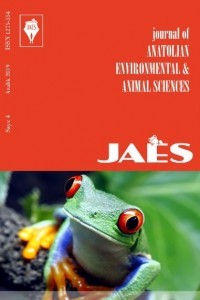Artvin (Türkiye)’nin Yarı Kurak Erozyonlu Alanlarında Kapari’nin Toprak Koruma Yeteneği ve Büyüme Performansının Belirlenmesi
Kapari, erozyon, yüzeysel akış, sediment, sediment konsantrasyonu, Artvin
Determination of the Growth Performance and Soil Protection Ability of the Caper (Capparis sp) in Eroded Site in Semi-Arid Region of Artvin, Turkey
Caper, eroded site, semi-arid, runoff, sediment, sediment concentration,
___
- Acar C, Bilgin F, Gül A. 2002. Manisa Sarıgöl Yöresindeki Erozyon Sahalarında Ormancılık-Karma Ormancılık-Tarım-Mera Amaçlı Kullanım Tekniklerine Uygun Bazı Bitki Türlerinin Belirlenmesi ve Erozyon Kontrolü Üzerine Etkileri. Teknik Bülten No: 019, Orman Bakanlığı Yayın No: 155 Ankara. Adekalu KO, Olorunfemi IA, Osunbitan JA. 2007. Grass mulching effect on infiltration, surface runoff and soil loss of three agricultural soils in Nigeria. Bioresource Tech, 98: 912– 917. Andreu V, Rubio JL, Gimeno-Garcı́a E, Llinares JV. 1998. Testing three Mediterranean shrub species in runoff reduction and sediment transport. Soil and Tillage Research, 45(3–4): 441-454. Angima SD, Stott DE, O'Neill MK, Ong CK, Weesies GA. 2002. Use of callindra–Napier grass contour hedges to control erosion in central Kenya. Agric. Ecosyst.Environ., 91: 15–23. Babalola O, Oshunsanya SO, Are K. 2007. Effects of vetiver grass (Vetiveria nigritana) strips, vetiver grass mulch and an organomineral fertilizer on soil, water and nutrient losses and maize (Zea mays, L) yields. Soil Tillage Res., 96:6–18. Brady NC, Weil RR. 1999. The Nature and Properties of Soils. New Jersey: Prentice Hall Publishing, Calvo-Cases A, Boix-Fayos C, Imeson AC. 2003. Runoff generation, sediment move-ment and soil water behaviour on calcareous (limestone) slopes of some Mediterra-nean environments in southeast Spain. Geomorphology, 50: 269–291. Dokuz, A., 2000. Geology, geotectonics, geochemistry and petrogenesis of magmatic and metamorphic rocks in Yusufeli (Artvin–Turkey)]. Ph.D. thesis, Karadeniz Technical University, Trabzon–Turkey [in Turkish, unpublished], 311 p. Garcia-Estringana P, Alonso-Blázquez N, Marques MJ, Bienes R, González-Andrés F, Alegre J. 2013. Use of Mediterranean legume shrubs to control soil erosion and runoff in central Spain. A large-plot assessment under natural rainfall conducted during the stages of shrub establishment and subsequent colonisation. CATENA, 102: 3-12. Chirino A, Bonet J, Sanchez JR. 2006. Effects of 30-year-old Aleppo pine plantations on runoff, soil erosion, and plant diversity in a semi-arid landscape in south eastern Spain. Catena, 65 (1): 19-29. Ghawi I, Battikhi A. 1986. Water melon production under mulch and trickle irrigation in the Jordan Valley. Journal of Agronomy and Crop Sci., 157: 145–155 Kara Z, Ecevit F, Karakaplan S. 1996. Toprak koruma elemanı ve yeni bir tarımsal ürün olarak kapari (Capparis spp.). Tarım-Çevre İlişkileri Sempozyumu, Mersin, pp. 919-929. Kelkit A, Müftüoğlu M. 2001. Çanakkale yöresi tarımında ve erozyonla mücadelede kapari (Capparis spinosa L.)’nin önemi. Atatürk Üniver., Ziraat Fakültesi Dergisi, 32 (3): 329-333. Kothyari BP, Verma PK, Joshi BK, Kothyari UC, 2004. Rainfall–runoff–soil and nutri-ent loss relationships for plot size areas of Bheta Gad watershed in Central Himalaya. India. J. Hydrol., 293: 137–150. Li XY, Gao SY, Xu HY, Liu LY. 2006. Growth of Caragana korshinskii using runoff-collecting microcatchments under semiarid condition. Journal of Hydrology, 328 (1–2): 338-346. Martínez Raya A, Durán Zuazo VH, Francia Martínez JR. 2006. Soil erosion and runoff response to plant-cover strips on semiarid slopes (SE Spain). Land Degradation and Development, 17(1):1–11. Mohammad AG, Adam MA. 2010. The impact of vegetative cover type on runoff and soil erosion under different land uses. Catena, 81 (2): 97–103. Nunes AN., de Almeida AC, Coelho COA. 2011. Impacts of land use and cover type on runoff and soil erosion in marginal area of Portugal. Appl. Geogr., 31: 687–699. Ölmez Z. 2001. Capparis ovata Desf. (kapari) nın Fidanlık Tekniği ve Artvin Yöresinde Plantasyon Denemeleri. Trabzon: KTÜ Fen Bilimleri Enstitüsü, Doktora Tezi, 144pp. Özdemir F, Öztürk M. 1996. Batı Anadolu'da yayılış gösteren Capparis L. türlerinin bireysel ekolojisi üzerine bir araştırma, Turkish Journal of Botany, 20(2): 189-199. Özturan S. 2007. Çukurova Koşullarında Capparis ovata’da Farklı Ekim Sıklıklarının Verime Etkisi, Adana: Çukurova Üniversitesi Fen Bilimleri Enstitüsü, Yüksek Lisans Tezi, 47pp. Smets, T, Poesen, J, Knapen A., 2008. Spatial scale effects on the effectiveness of organic mulches in reducing soil erosion by water. Earth-Science Reviews, 89: 1-12.
- Yüksek F, Yüksek T. 2007. Artvin Yusufeli yöresinde korunganın toprak koruma yeteneğinin belirlenmesi. Türkiye VII. Tarla Bitkileri Kongresi, 25-27 Haziran 2007 Erzurum, Bildiriler 2 Çayır Mera Yem Bitkileri ve Endüstri Bitkileri, 143-147. Yüksek T, Yüksek F, Özalp M, Ölmez Z. 2009. Artvin Pamukçular Yöresinde Kapari (Capparis ovata Desf.) ve Korunganın (Onobrychis viciifolia Scop.) Toprak Koruma Yeteneklerinin Karşılaştırılması.TÜBİTAK –TOVAK Proje No:1040116, 65 pp. Yüksek, T., Yüksek, F., 2011. The effects of restoration on soil properties in degraded land in the semi-arid region of Turkey, Catena, 84: (1-2), 47-53. Yüksek F, Yüksek T, 2015. Growth performance of sainfoin and its effects on the runoff, soil loss and sediment concentration in a semi-arid region of Turkey. Catena, 133: 309–317. Zhang GH, Liu GB, Wang GL. 2010. Effects of Caragana Korshinskii Kom. cover on runoff, sediment yield and nitrogen loss. International Journal of Sediment Research., 25( 3), 245-257. Zhou ZC, Shangguan ZP. 2008. Effect of Ryegrasses on Soil Runoff and Sediment Control. Pedosphere 18(1): 131–136. Xu XL, Ma KM, Fu BJ Liu W, Song CJ. 2009. Soil and water erosion under different plant species in a semiarid river valley, SW China: the effects of plant morphology, Ecological Research. 24 (1):37–46.
- Yayın Aralığı: Yılda 4 Sayı
- Başlangıç: 2016
- Yayıncı: Bülent VEREP
Technical Specifications of Fishing Fleet in Giresun Province
Cengiz MUTLU, Cengaver Murad UNCUMUSAOĞLU, Bülent VEREP
Azerbaycan’ın Sucul Orman Birliklerinin Fitososyolojik Özellikleri
Vagıf ATAMOV, Murat MUSAYEV, Türkane QULİYEVA
Turan YÜKSEK, Filiz YÜKSEK, Mehmet ÖZALP, Zafer ÖLMEZ
Türkiye’ye Endemik Rana tavasensis (Baran and Atatür, 1986) Türüne Ait Yeni Lokalite Kaydı
